Long ago in the misty depths of time – that’s last year, actually, I posted a piece about Ladakh (you can find it here if you’d like to read it.)
This, then, is another mixture of photographs and entries from my journal of my 2005 trip to India, which included a couple of weeks spent in Ladakh. I went comparatively early in the year, when the nights are still extremely cold and very few visitors have made their way up from the plains.
Just the way I like it!
Ladakh is high. If you fly in from Delhi (the only way to enter Ladakh for 8 months of the year), you travel from around sea level to 3500m in no time at all. Ladakh means ‘The Land of High Passes’, and is aptly named. Leh, the capital, at 3500m, is one of the lower areas of Ladakh. It’s all uphill from there. Winters are incredibly harsh and the summer growing season brief, yet the Ladakhis traditionally are self-sufficient in everything they need – food, clothing and shelter – and have only recently collided with the western consumer society. In contrast with most of the rest of India, the religion and culture of the majority of the people there is Tibetan Buddhism.
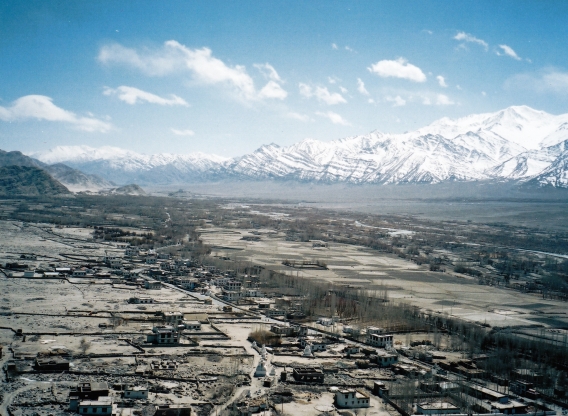
The Roof of the World – View across the Indus valley at 3500m, Thikse, Ladakh.
Friday 8th April 2005
I’m in Ladakh and, hey, wow!
At the airport for 4.30am, to find the flight postponed until 8am, due to weather conditions. It all looked ominous, but just after 7am we were told to check in and after numerous baggage checks, body checks, baggage identifications, etc, we were away at 8.30.
I’ve heard the flight described as one of the most spectacular in the world. I’ve also heard it described as jaw-dropping. I can imagine that it could be bowel-dropping. As we approached the Himalaya, clouds steadily built up and we flew through with tantalising glimpses of great snow-covered ranges below, through the occasional gaps in the cloud. After a while the turbulence built up and we were buffeted quite considerably. Then as we began to near Leh, we slowly lost height, the turbulence increased and we got more views of peaks at under-carriage height. Once we had dropped out of the clouds and the whole valley lay spread into the distance surrounded by snow-swept mountains, it was indeed jaw-dropping.
Then into land after three slow circles around the airstrip. The outside temperature was 2C, we were told, but it certainly didn’t seem that cold.
Once we’d gone through the formalities of registration and baggage reclaim with the refreshingly friendly ground staff, I walked out into the front of the airport and found a taxi. Yousef charged me RS 100/- to go to my choice of guesthouse (The Ti-Sei) and left me his mobile number. He also gave me all the usual (sensible) advice about taking it easy for a day or so.
I’m now sitting in a splendid light and airy room, looking out across the vegetable garden (covered in this morning’s snowstorm) to lines of bare poplars, traditional houses and some splendid mountains, also covered in snow.

Cairn at top of mountain north of Leh.
After a Ladakhi lunch of apricots, apple juice and water, headed north past the Shanti Stupa towards the first line of hills. Reached there at 1.15pm and stopped there for a breather. Silence. Apart from the pounding of the blood in my head. Absolute silence. After a few minutes the call of the muezzin drifts up from Leh, from the Jama Masjid. Then a few bird calls from the crags. Perfect peace. A perfect desert landscape, with pockets of snow. I’m sitting on a boulder, warmed by the sun, my feet in patches of fresh snow.

Gompa just below Leh Palace, Leh, ladakh.

Man spinning prayer wheel, Leh. To Ladakhis, their religion is not somehow separate from their daily life, but an essential part of it.
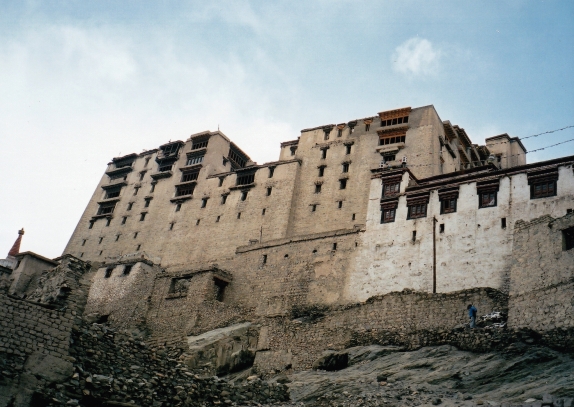
Leh Palace. Very similar to the Potala in Lhasa, although smaller, this was the home of Ladakh’s royal family from the 17th century, when it was built, until the mid 19th century when they moved to the palace at Stok, on the other side of the Indus Valley, as a result of an invasion by Kashmiri forces.
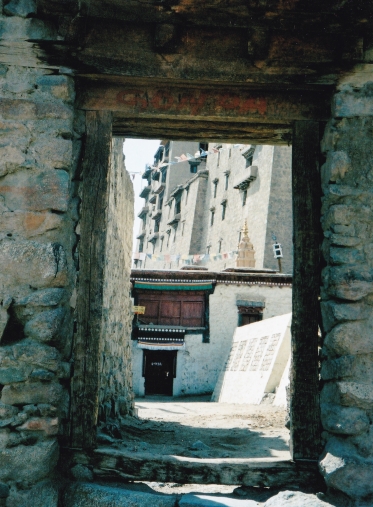
Gateway to Gompa at Leh Palace.

Old buildings on the outskirts of Leh, ladakh. Traditional Ladakhi buildings closely resemble those of Tibet. In fact, there are so many similarities between the two areas, that Ladakh is often referred to as ‘Little Tibet’.
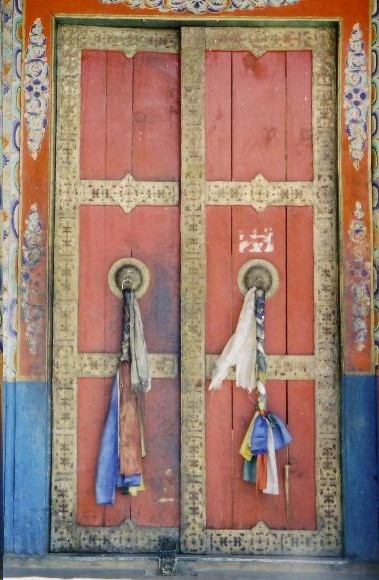
Temple Door at the Monastery at Thikse, Ladakh.
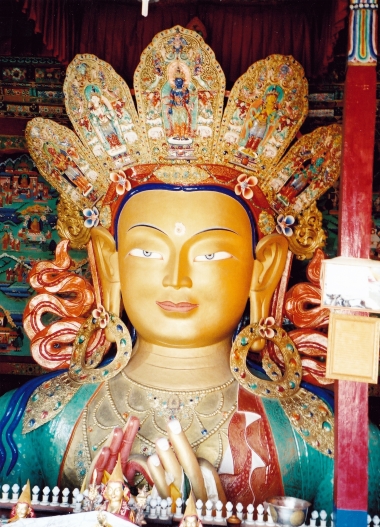
Statue of Maitreya, the Future Buddha, at Thikse Gompa. This statue, 2 stories high (15 metres) in it’s own temple was completed in 1981.

Wonderful place on earth
LikeLiked by 1 person
It is a wonderful place. Thank you!
LikeLiked by 1 person
Welcome
LikeLiked by 1 person
Just stunning!
LikeLiked by 2 people
Thanks, Lucy!
LikeLiked by 1 person
My pleasure!
LikeLiked by 1 person
Such different vistas and way of life. It is hard to imagine places like this exist.
LikeLiked by 2 people
It does look so different from ‘here’!
LikeLiked by 1 person
Lovely pictures. It’s also great place for not doing much and just chilling around.
LikeLiked by 1 person
Oh, I know. So tempting!
LikeLiked by 1 person
Don’t ask! Been itching to travel to Let…
LikeLiked by 1 person
Oh, I so enjoy your posts, such experiences, such memories and I love the fact that we can also enjoy your travels via this blogging experience. Great post Mick, what a beautiful place, you brought this remote place into my reader and it’s probably somewhere I’ll never get to go, but I’ve touched on it, via you, thank you …
LikeLiked by 1 person
Lovely words, Vicky, thank you! And you never know…it’s certainly worth the effort of getting there!
LikeLiked by 1 person
Terrific photos! Thanks for sharing these, Mick. (And as for the plane ride, better you than me. I don’t handle turbulence well!)
LikeLiked by 1 person
You’re welcome, Ann. It was quite an experience! (Mind you, taking off from Leh to return to Delhi was even more exciting, but perhaps I’ll share that another time!)
LikeLiked by 1 person
Had the privilege of spending a couple of weeks in Ladakh back in 1992. A stunning, awe-inspiring place. You’ve captured it beautifully, Mick.
LikeLiked by 1 person
Thank you, and thanks for visiting!
LikeLike
Nice to see your Ladakh experiences, that also of year 2005. Thank you very much Mick for sharing it. I had the privilege to visit this place in 2010. Liked your pictures also.
LikeLiked by 1 person
You’re very welcome. Hopefully, I’ll get back there again, sometime. Thanks for visiting.
LikeLike
Good luck …
LikeLiked by 1 person
Quite a view from the roof. I assume you did take it easy for a couple days?
LikeLike
Well, sort of. I did a lot of exploring, too!
LikeLiked by 1 person
Fascinating photographs as always, Mick, and very interesting to hear about your journey and your experiences while visiting Ladakh. I particularly liked the photograph of the Temple Door at the Monastery at Thikse, Ladakh. I do have a particular liking for pictures of doors and windows for some reason. I always admire the beautiful blue doors of the picture on your blog page with an invitation to visit your art gallery which I have also done in the past. Glad you enjoyed your break and the experience.
LikeLiked by 1 person
Thanks, Ellie. I have a thing about doors too, as I’m sure you’ve noticed. They certainly make great subjects for both paintings and photographs.
LikeLike
Beautiful images–thanks for sharing. 🙂
LikeLiked by 1 person
Thanks, Cathleen.
LikeLiked by 1 person
This looks like a great place to sit back and enjoy the view in peace and harmony. The rest of the world may be flying by, but I suspect that if you were to return there now (12 years later) that many of the scenes would be soothingly similar. Love it!
LikeLiked by 1 person
i think lots would be, Gabe. The capital was becoming depressingly built up (in the wrong way) in places, but hopefully the small places would still be fairly pristine.
LikeLiked by 1 person
I think your description was most apt, the top of the world, or the roof of the world. I thoroughly enjoy your travel blogs and photographs. Wonderful stuff. Thank you
LikeLiked by 1 person
Thanks, Jackie. And thanks for the visits and the comments.
LikeLike